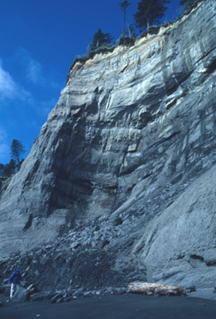Geotimes

Untitled Document

News Notes
Seismology
Deep sediments, strong quakes
The surprising strength of the magnitude-9 earthquake that triggered the destructive tsunami in Sumatra in
December 2004 gave seismologists new urgency to discover characteristics that lead up to very large events. New models
show that responsibility might rest on sediments that sometimes collect kilometers deep at the junctions of tectonic plates.
 Sediments
erode from a cliff located along the Olympic Coast in the state of Washington.
Similar types of sediments are filling basins underwater, and could be a contributing
factor behind large subduction-zone earthquakes. Image courtesy of Christopher
Fuller.
Sediments
erode from a cliff located along the Olympic Coast in the state of Washington.
Similar types of sediments are filling basins underwater, and could be a contributing
factor behind large subduction-zone earthquakes. Image courtesy of Christopher
Fuller.
Subduction zones, where two plates meet and one pushes below the other, have hosted many of the world’s largest
earthquakes, including the Sumatra event, Kamchatka’s magnitude-9.0 earthquake in 1952 and Chile’s magnitude-9.5 earthquake
in 1960, according to the U.S. Geological Survey. Yet other regions along subduction zones rest quietly.
A reason for the variation is evident in previous experiments that show that portions of subduction faults slip
regularly, allowing stress to dissipate and making strong earthquakes less likely. In other “locked” portions of
faults, however, stress tends to build, which can lead to large earthquakes when they finally slip.
How long plates stay locked together determines an earthquake’s ultimate size, says Christopher Fuller, a
seismologist at the University of Washington in Seattle. And according to new models that Fuller and colleagues
put together, sediments help plates maintain their strength and stay locked, potentially leading to large earthquakes.
The models, published in the February Geology, have spurred Fuller and
colleagues to consider new hypotheses that could one day help researchers determine
where large earthquakes are most likely to strike. But just as important, Fuller
says, the models “put down a really simple explanation for a really complicated
process.”
Fuller’s team modeled plate strength in two computer simulations that show the cross section of a plate subducting
beneath another plate, creating a bowl-shaped depression on the upper plate. The models suggest that when sediments are
present, the upper plate is actually strengthened and deforms less than upper plates without sediments. These stronger
plates, Fuller says, set the stage for larger earthquakes by allowing them to stay locked longer.
The correlation is evident to varying degrees in both the Kamchatka and Sumatra events, says Roland Burgmann,
a seismologist at the University of California in Berkeley. The processes tested by Fuller’s models are “fundamental”
to understanding subduction-zone earthquakes, Burgmann says.
Researchers are still uncertain, however, why some plates maintain strong stable contact for longer periods of times
and trigger larger earthquakes. One idea centers around the idea of plate deformation. The more sediment loaded onto
the top plate, the less it will deform and the more slip will occur at the plate interface.
Additionally, Fuller says, sediment on the top plate may keep the plate in stationary contact. The longer the plates
stay in stationary contact, the more violent the result will be when the plates finally slip past each other. Conversely,
smaller earthquakes are more likely to occur where the upper plate is not bearing sediment, as it is then free to slip more
over time.
Another option is that sediments are controlling the movement of fluids that reside between plates. Under conditions
free of sediment, mantle fluids can easily escape. Plates reinforced by sediment, however, make that escape more
difficult, and pressure could build up until the fault finally fractures. Any of these processes could be
occurring separately or together, Fuller says. “It’s really that we just don’t know yet.”
Fuller hopes that his models initiate discussion about why large earthquakes strike particular regions, and
encourages seismologists to consider “things that haven’t been considered before.” Each basin, from Sumatra to
Kamchatka, “is a little different,” he says.
Kathryn Hansen
Back to top
Untitled Document

 Sediments
erode from a cliff located along the Olympic Coast in the state of Washington.
Similar types of sediments are filling basins underwater, and could be a contributing
factor behind large subduction-zone earthquakes. Image courtesy of Christopher
Fuller.
Sediments
erode from a cliff located along the Olympic Coast in the state of Washington.
Similar types of sediments are filling basins underwater, and could be a contributing
factor behind large subduction-zone earthquakes. Image courtesy of Christopher
Fuller.
